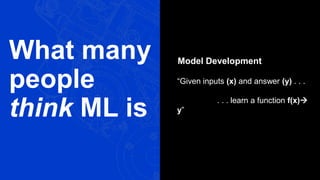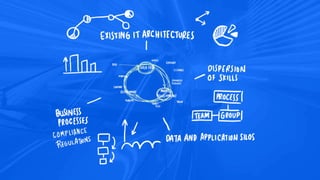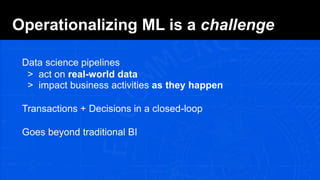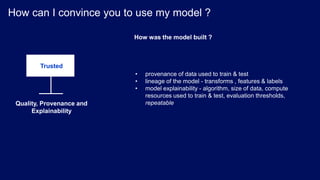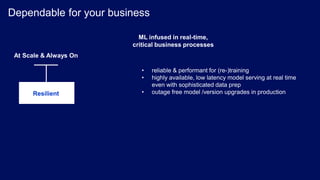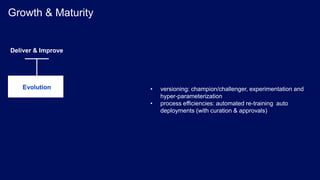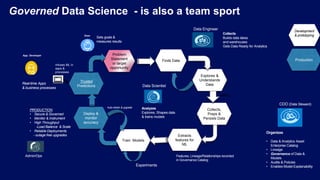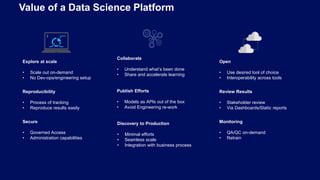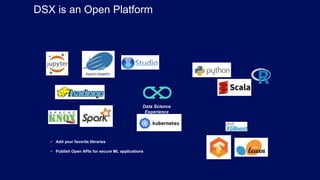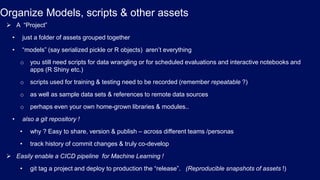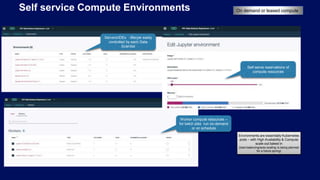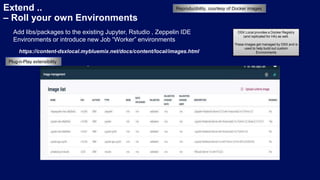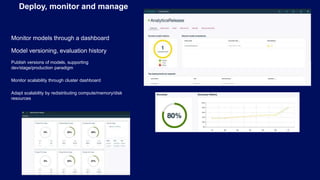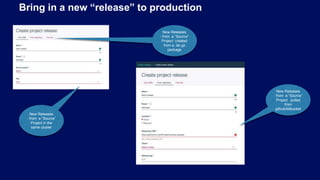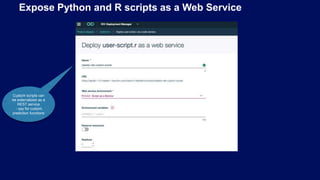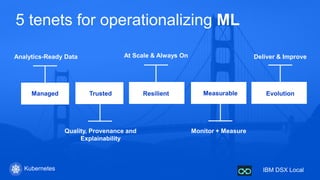Machine Learning Models in Production
- 1. Operationalizing Machine Learning Models in production —
- 2. What many people think ML is “Given inputs (x) and answer (y) . . . . . . learn a function f(x) y” Model Development
- 3. What real-world ML actually looks like:
- 8. Operationalizing ML is a challenge Data science pipelines > act on real-world data > impact business activities as they happen Transactions + Decisions in a closed-loop Goes beyond traditional BI
- 9. 5 tenets for operationalizing ML Analytics-Ready Data Managed Trusted Quality, Provenance and Explainability Resilient Measurable Monitor + Measure Evolution Deliver & ImproveAt Scale & Always On
- 10. Where’s my data ? Analytics-Ready Data Managed • access to data with techniques to track & deal with sensitive content • data virtualization • automate-able pipelines for data preparation, transformations
- 11. How can I convince you to use my model ? • provenance of data used to train & test • lineage of the model - transforms , features & labels • model explainability - algorithm, size of data, compute resources used to train & test, evaluation thresholds, repeatable Trusted Quality, Provenance and Explainability How was the model built ?
- 12. Dependable for your business Resilient At Scale & Always On • reliable & performant for (re-)training • highly available, low latency model serving at real time even with sophisticated data prep • outage free model /version upgrades in production ML infused in real-time, critical business processes
- 13. Is my model still good enough ? Measurable Monitor + Measure • latency metrics for real-time scoring • frequent accuracy evaluations with thresholds • health monitoring for model decay
- 14. Growth & Maturity Evolution Deliver & Improve • versioning: champion/challenger, experimentation and hyper-parameterization • process efficiencies: automated re-training auto deployments (with curation & approvals)
- 15. Governed Data Science - is also a team sport Data Engineer CDO (Data Steward) Data Scientist Organizes • Data & Analytics Asset Enterprise Catalog • Lineage • Governance of Data & Models • Audits & Policies • Enables Model Explainability Collects Builds data lakes and warehouses Gets Data Ready for Analytics Analyzes Explores, Shapes data & trains models Exec App. Developer Problem Statement or target opportunity Finds Data Explores & Understands Data Collects, Preps & Persists Data Extracts features for ML Train Models Deploy & monitor accuracy Trusted Predictions Experiments Sets goals & measures results Real-time Apps & business processes Infuses ML in apps & processes PRODUCTION • Secure & Governed • Monitor & Instrument • High Throughput -Load Balance & Scale • Reliable Deployments - outage free upgrades Auto-retrain & upgrade Refine Features, Lineage/Relationships recorded in Governance Catalog Development & prototyping Production Admin/Ops
- 16. Operationalizing ML for the Enterprise - Requirements & implications 16 On demand or leased compute Scale out for users & workloads Serve Models in Real-time APIs Load Balancing Resiliency Service Discovery Role Based ACL & tenancy Network PoliciesSecure Trusted Predictions a Platform Notebooks & IDEs Model Evaluations an Integrated Experience Continuous Delivery (automatic) Rolling upgrades Teaming Collaborations Extensible Get Data Ready for Analytics Data Prep Plug-n-Play extensibility Kubernetes IBM DSX Local Tools Packages & Algorithms
- 17. Explore at scale • Scale out on-demand • No Dev-ops/engineering setup Reproducibility • Process of tracking • Reproduce results easily Secure • Governed Access • Administration capabilities Collaborate • Understand what’s been done • Share and accelerate learning Publish Efforts • Models as APIs out of the box • Avoid Engineering re-work Discovery to Production • Minimal efforts • Seamless scale • Integration with business process Open • Use desired tool of choice • Interoperability across tools Review Results • Stakeholder review • Via Dashboards/Static reports Monitoring • QA/QC on-demand • Retrain Value of a Data Science Platform
- 18. Data Science Experience DSX is an Open Platform Add your favorite libraries Publish Open APIs for secure ML applications
- 19. Organize Models, scripts & other assets A “Project” • just a folder of assets grouped together • “models” (say serialized pickle or R objects) aren’t everything o you still need scripts for data wrangling or for scheduled evaluations and interactive notebooks and apps (R Shiny etc.) o scripts used for training & testing need to be recorded (remember repeatable ?) o as well as sample data sets & references to remote data sources o perhaps even your own home-grown libraries & modules.. • also a git repository ! • why ? Easy to share, version & publish – across different teams /personas • track history of commit changes & truly co-develop Easily enable a CICD pipeline for Machine Learning ! • git tag a project and deploy to production the “release”. (Reproducible snapshots of assets !)
- 20. Build & Collaborate Collaborate within git-backed projects
- 21. Essential tools for Data Scientists Jupyter notebook Environment Python 2.7/3.5 with Anaconda Scala, R R Studio Environment with > 300 packages, R Markdown, R Shiny Zeppelin notebook with Python 2.7 with Anaconda
- 22. Self service Compute Environments Servers/IDEs - lifecyle easily controlled by each Data Scientist Self-serve reservations of compute resources Worker compute resources – for batch jobs run on-demand or on schedule Environments are essentially Kubernetes pods – with High Availability & Compute scale-out baked in (load-balancing/auto-scaling is being planned for a future spring) On demand or leased compute
- 23. Extend .. – Roll your own Environments Add libs/packages to the existing Jupyter, Rstudio , Zeppelin IDE Environments or introduce new Job “Worker” environments https://content-dsxlocal.mybluemix.net/docs/content/local/images.html DSX Local provides a Docker Registry (and replicated for HA) as well. These images get managed by DSX and is used to help build out custom Environments Plug-n-Play extensibility Reproducibility, courtesy of Docker images
- 24. Automate .. Jobs – trigger on-demand or by a schedule. such as for Model Evaluations, Batch scoring or even continuous (re-) training
- 25. Monitor models through a dashboard Model versioning, evaluation history Publish versions of models, supporting dev/stage/production paradigm Monitor scalability through cluster dashboard Adapt scalability by redistributing compute/memory/disk resources Deploy, monitor and manage
- 26. Deployment manager - Project Releases Project releases Deployed & (delta) updatable Current git tag
- 27. Bring in a new “release” to production New Releases - from a “Source” Project in the same cluster New Releases - from a “Source” Project pulled from github/bitbucket New Releases - from a “Source” Project created from a .tar.gz package
- 28. Expose a ML model via a REST API replicas for load balancing pick a version to expose (multiple deployments are possible too..) Optionally reserve compute scoring end-point Model pre-loaded into memory inside scoring containers
- 29. Expose Python and R scripts as a Web Service Custom scripts can be externalized as a REST service - say for custom prediction functions
- 30. DSX Local Architecture overview Customer Systems DSX Local Cluster Relational Data Stores (DB2,Oracle, Teradata, etc.) LDAP/AD (Authentication) Spark Cluster (via Livy) Hadoop (HDFS, Hive, IBM Big SQL) Admin interfaces Metering Monitoring Kubernetes Master Components Platform Control & Management Redis (session store) Shared user volume Cloudant (metadata) Storage Management Services registry vol (dockeri mages) KubernetesCluster csv files, projects, models Kubernetes cluster spread across multiple servers Data Scientist – web browser & API • Start with 3 nodes with HA enabled • Expand as needed GitHub & GitHub Enterprise (projects & assets) Kubernetes Persistent Volumes Integrations & Connections Project services, Data Sources & .git Spark, Spark-ML Environments: Resource mgmt & Jobs Core Services User Management & tokens DSX Hadoop Integration Service Custom Scorers Model Evaluations Project Releases: Deployment/Scale-out load balancing & Monitoring Model Mgmt & Deployment + operations Scorers Package & Image mgmt Jupyter (anaconda-python, scala, R) Tensorflow-GPU Zeppelin Scripts (.py, .R) & Jobs Data Scientist Dev environment RStudio (and Shiny Apps) Projects, Publish & collaborations Data Refinery SPSS Modeler (add-on) Decision Opt/CPLEX (add-on) H20 Flows (add-on) Jobs & Scheduling Hosted Apps Webservices (Python,R) Batch Scoring Jupyter notebook apps R.Shiny apps
- 31. Operationalizing Machine Learning Models in production — Summary
- 32. 5 tenets for operationalizing ML Analytics-Ready Data Managed Trusted Quality, Provenance and Explainability Resilient Measurable Monitor + Measure Evolution Deliver & ImproveAt Scale & Always On IBM DSX LocalKubernetes


